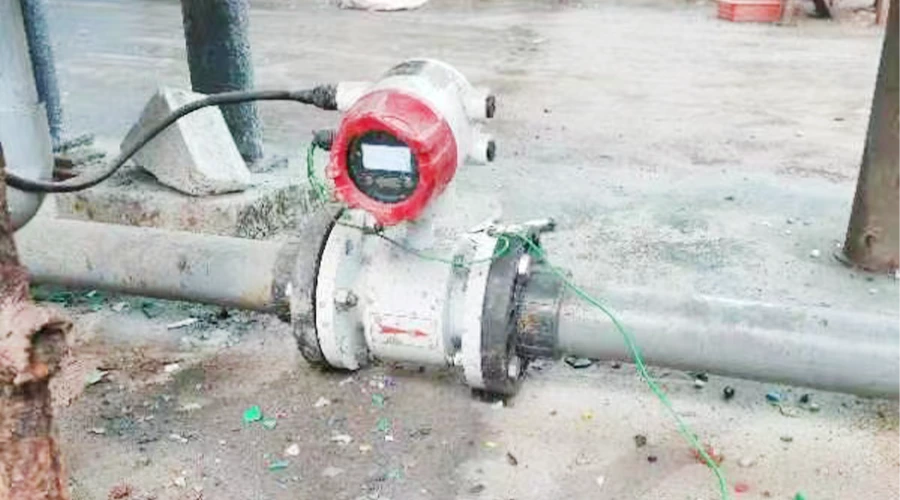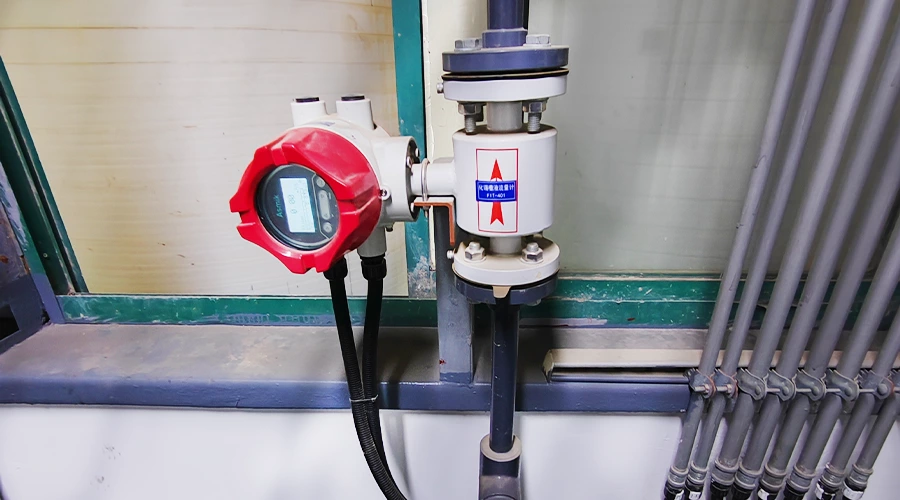Electromagnetic Water Flow Meter: Accurate Flow Measurement Made Easy
Introduction
Water flow measurement is an essential aspect of many industries and sectors, ranging from municipal water management to chemical processing plants. Traditional flow measurement methods, such as mechanical meters, can be prone to inaccuracies and require regular maintenance. Electromagnetic water flow meters offer a modern and reliable solution that overcomes many of these limitations.
What is an Electromagnetic Water Flow Meter?
An electromagnetic water flow meter is a device that utilizes Faraday's law of electromagnetic induction to measure the flow rate of conductive fluids, including water. It consists of a sensor that generates a magnetic field across the flow path and electrodes that measure the voltage induced by the moving fluid. The induced voltage is directly proportional to the velocity of the fluid, allowing for accurate flow rate calculations.
How Does an Electromagnetic Water Flow Meter Work?
An electromagnetic water flow meter operates on the principle of electromagnetic induction. As the conductive fluid flows through the pipe, it cuts across the magnetic field created by the sensor. According to Faraday's law, this movement induces a voltage in the fluid, which is sensed by the electrodes. By measuring the induced voltage, the flow meter can determine the flow velocity and calculate the volumetric or mass flow rate.
The magnetic field strength, generated by the sensor, plays a crucial role in the accuracy of the measurement. The electrode arrangement ensures that the voltage is measured accurately across the fluid's cross-sectional area. Sophisticated algorithms and signal processing techniques further enhance the accuracy and stability of the measurements.
Advantages of Electromagnetic Water Flow Meters
Electromagnetic water flow meters offer several advantages over other types of flow meters:
- High accuracy and repeatability: Electromagnetic flow meters provide precise and consistent flow measurements, making them suitable for applications where accuracy is critical.
- Wide range of flow measurement capabilities: These flow meters can handle a broad range of flow rates, from low to high, ensuring versatility in various industrial processes.
- No moving parts, resulting in low maintenance: Unlike mechanical flow meters, electromagnetic flow meters have no moving parts that can wear out or become clogged. This reduces maintenance efforts and enhances the longevity of the device.
- Compatible with various types of fluids: Electromagnetic water flow meters can measure not only clean water, but also conductive fluids with suspended particles or chemicals. This makes them suitable for diverse applications.
- Resistant to temperature and pressure variations: These flow meters can operate reliably in a wide range of temperature and pressure conditions, making them suitable for demanding environments.
Applications of Electromagnetic Water Flow Meters
Electromagnetic water flow meters find applications in various industries and sectors:
- Water distribution and management systems: Municipal water supply networks, water treatment plants, and irrigation systems rely on electromagnetic flow meters to accurately monitor and control water flow.
- Industrial processes and manufacturing: Chemical processing plants, pharmaceutical production, food and beverage industries, and many other manufacturing processes benefit from precise flow measurement for process optimization and quality control.
- Wastewater treatment plants: Monitoring and managing the flow of wastewater is crucial for efficient treatment processes. Electromagnetic flow meters help ensure accurate measurements in these demanding environments.
- Agriculture and irrigation systems: Proper water management in agriculture is essential for crop yield and sustainability. Electromagnetic flow meters enable farmers to optimize irrigation and minimize water wastage.
- HVAC and cooling systems: Heating, ventilation, and air conditioning systems rely on accurate flow measurements for efficient operation. Electromagnetic flow meters provide the necessary data for effective system control.

Factors to Consider When Choosing an Electromagnetic Water Flow Meter
When selecting an electromagnetic water flow meter for a specific application, several factors need to be considered:
- Flow rate, range and accuracy requirements: Determine the anticipated flow rate, range and the required level of accuracy for your application. This will help you choose a flow meter with the appropriate specifications.
- Pipe size, and compatibility: Consider the size of the pipe where the flow meter will be installed. Ensure that the flow meter is compatible with the pipe size to ensure accurate measurements.
- Material compatibility, and environmental conditions: Evaluate the fluid's composition and temperature to ensure the flow meter's materials can withstand the specific environment. Corrosive or abrasive fluids may require specialized materials.
- Output options and communication protocols: Consider the data output options provided by the flow meter, such as analog, digital, or wireless interfaces. Compatibility with your existing monitoring systems and communication protocols should also be assessed.
- Cost and long-term investment considerations: While cost is an important factor, it should be balanced with the overall performance and reliability of the flow meter. Consider the long-term maintenance requirements and potential cost savings associated with accurate flow measurement.
Installation and Maintenance of Electromagnetic Water Flow Meters
Proper installation and regular maintenance are crucial for the optimal performance of electromagnetic water flow meters. Here are some key considerations:
- Proper positioning and mounting guidelines: Follow the manufacturer's guidelines for installing the flow meter in the pipeline. Ensure that there are no obstructions or bends upstream and downstream of the flow meter that could affect the measurements.
- Calibration and zero adjustment procedures: Calibrate the flow meter according to the manufacturer's recommendations to ensure accurate measurements. Zero adjustment may be required periodically to compensate for any drift.
- Regular inspection and cleaning practices: Periodically inspect the flow meter for any signs of fouling, buildup, or damage. Clean the electrodes and ensure that they are free from debris to maintain accurate measurements.
- Troubleshooting common installation issues: In case of unexpected readings or performance issues, consult the user manual or contact the manufacturer's technical support for troubleshooting assistance. Common issues may include improper grounding, incorrect wiring, or signal interference.
Common Challenges and Troubleshooting Tips
While electromagnetic water flow meters are highly reliable, some challenges may arise. Here are a few common issues and troubleshooting tips:
- Signal interference and noise reduction techniques: Electromagnetic flow meters can be susceptible to electrical noise, which can affect the accuracy of the measurements. Proper grounding, shielding, and isolation techniques can help minimize signal interference.
- Electrode coating and fouling prevention: Buildup of deposits on the electrodes can lead to inaccurate readings. Regular cleaning and maintenance, along with the use of specialized coatings, can help prevent fouling and ensure reliable measurements.
- Handling air bubbles and gas content in the fluid: Air bubbles or the presence of gas in the fluid can affect the measurements. Installing the flow meter in a way that allows the air bubbles to escape or using air bubble compensation algorithms can help mitigate this issue.
- Addressing magnetic field disturbances: External magnetic fields can interfere with the flow meter's measurements. Ensure that the flow meter is installed away from sources of magnetic fields, such as motors or power cables.
- Dealing with power supply and grounding issues: Proper grounding and stable power supply are essential for accurate measurements. Ensure that the power supply meets the manufacturer's specifications, and the flow meter is correctly grounded.
Compared with Other Types of Water Flow Meters
Electromagnetic water flow meters have distinct advantages over other types of flow meters:
Ultrasonic flow meters: While both types offer high accuracy, ultrasonic flow meters may be affected by the fluid's properties, such as temperature or gas content. Electromagnetic flow meters are not affected by such factors and can handle a wider range of fluids.
Turbine flow meters: Turbine meters have moving parts that can wear out over time, requiring regular maintenance. Electromagnetic flow meters, with no moving parts, offer better longevity and require minimal maintenance.
Positive displacement flow meters: Positive displacement meters measure flow by dividing the fluid into discrete volumes. They may be accurate for low flow rates but struggle with higher flow rates. Electromagnetic flow meters can accurately measure a wide range of flow rates without limitations.

Future Trends in Electromagnetic Water Flow Meter Technology
The field of electromagnetic water flow meters continues to evolve, with several future trends emerging:
- Smart and wireless monitoring capabilities: Integration with smart technologies and wireless communication enables real-time monitoring, remote access, and data analytics for improved operational efficiency.
- Integration with IoT platforms: By connecting electromagnetic flow meters to the Internet of Things (IoT) platforms, users can gain valuable insights into flow patterns, identify anomalies, and optimize water management strategies.
- Advances in data analytics and predictive maintenance: With the increasing availability of data, advanced analytics algorithms can help identify potential issues, predict failures, and optimize maintenance schedules for electromagnetic flow meters.
- Miniaturization and improved energy efficiency: Ongoing research focuses on reducing the size and power consumption of electromagnetic flow meters, making them suitable for smaller-scale applications and enhancing energy efficiency.
Conclusion
Electromagnetic water flow meters provide accurate, reliable, and low-maintenance solutions for measuring the flow of conductive fluids. Their advantages, including high accuracy, compatibility with various fluids, and resistance to environmental conditions, make them indispensable in diverse industries. By understanding their working principles, installation considerations, and maintenance requirements, users can harness the full potential of electromagnetic water flow meters in their applications.
FQAs
Q1: Can an electromagnetic water flow meter measure corrosive fluids?
A1: Yes, electromagnetic water flow meters can measure corrosive fluids. However, it's crucial to select a flow meter with suitable materials of construction that can withstand the corrosive properties of the fluid.
Q2: What is the typical lifespan of an electromagnetic water flow meter?
A2: The lifespan of an electromagnetic water flow meter can vary depending on factors such as the operating conditions, maintenance practices, and the specific model. With proper installation and regular maintenance, electromagnetic flow meters can last 10 to 20 years or more.
Q3: How often should an electromagnetic water flow meter be calibrated?
A3: It is recommended to calibrate electromagnetic water flow meters at regular intervals, typically every one to two years. However, the calibration frequency may vary depending on the specific application and industry requirements. Consult the manufacturer's guidelines for precise recommendations.
Q4: Can an electromagnetic water flow meter be used for both clean and dirty water?
A4: Yes, electromagnetic water flow meters can measure both clean and dirty water, including fluids with suspended particles or impurities. However, for fluids with high concentrations of solid particles or debris, proper filtration and maintenance are essential to prevent clogging or damage to the flow meter.
Q5: Are there any size limitations for electromagnetic water flow meters?
A5: Electromagnetic water flow meters are available in a wide range of sizes, from small diameters suitable for residential applications to large diameters for industrial and municipal applications. The size of the flow meter should be selected based on the pipe size and the anticipated flow rate for accurate measurements.



